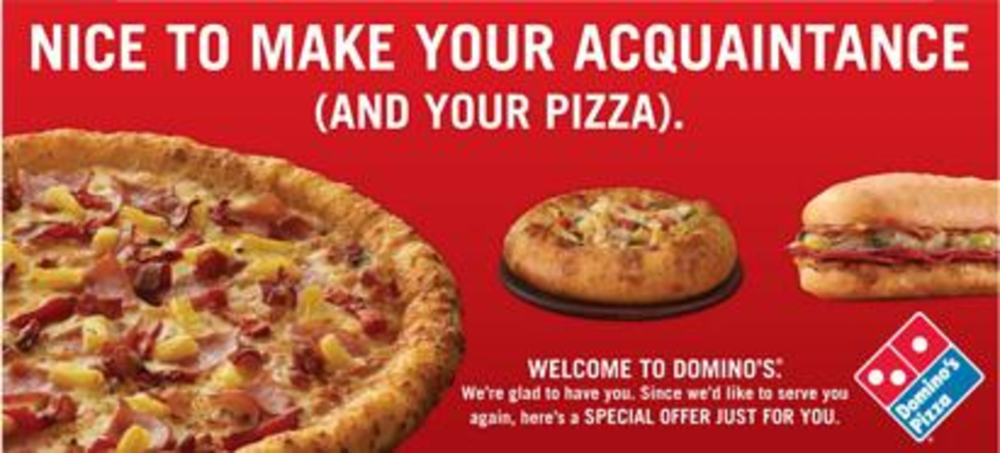Maintaining clean lists has always been important for marketers to manage relationships with customers and prospects. However, with the proliferation of channels and media, a single customer view can be challenging. Most marketers do not have a centralized database. Today, because of pinched budgets, marketers are working harder than ever to manage their data for a more complete, 360-degree view of their customers.
This is nothing new to Rob Weisberg, VP of multimedia marketing for Domino’s Pizza, which boasts a 99% US awareness rate and sends direct mail pieces to 70 million households.
“The difference between our CRM and list marketing [practices] five years ago compared to today is night and day,” he explains. “We began building response and retention models, and today we employ more than 45 models.”
Domino’s began working with CRM agency Razor about seven years ago for printing and production. Soon after, the agency took on data and analytics responsibilities.
With nearly 9,000 locations in more than 60 countries, each Domino’s store directly markets to consumers in that specific geographic area.
“Manhattan is very different than Wichita,” Weisberg says. “We use models and analytics to suggest promotions and prices to the franchise owners, but they have the right to choose.”
At any given time in the US, Domino’s has about 8,000 versions of direct mail, which is sent out about every two weeks. The company also has an online tool that allows each franchise to select its creative and offer and then order the pieces.
“This drastically cuts the order-to-deliver time,” Weisberg notes. “Previously, the process could have taken eight weeks — now it’s closer to two.”
Domino’s has different creative not only for different locations, but also for various points in the customer life cycle. For example, a welcome piece is sent to first-time customers. If a customer is flagged as only ordering via phone, they may receive a piece touting online ordering and the Domino’s Pizza Tracker. If a loyal customer has not ordered recently, they may receive a piece that says, “Let’s get together again.” Or, if a mistake was made in a previous order, the customer may receive a special offer with a “Let’s try this again” message.
Domino’s has its roots in direct mail, but e-mail has also become important for the company.
“Five years ago, we sent about 150,000 e-mails every eight weeks,” Weisberg says. “Today, there are more than 10 million [addresses] in our database, and we’ll send e-mails twice a week with varying offers and creative based on past purchase behavior.”
Online ordering may soon represent half of Domino’s business, says Weisberg, who expects half of its orders will be placed online by the end of 2011.
“Four and a half years ago, about one in five orders were placed online,” he notes. “A year later, we were the fifth-largest e-commerce site in terms of transactions, and today we’re second only to Amazon.”
Online ordering drives higher purchases per order, because users have the menu in front of them and the process is easy. Because there are fewer mistakes, customer satisfaction is high. And, data allows Domino’s to upsell based on past purchase behavior.
“If we know they ordered Cinna Stix in the past, we might offer those to them before checkout,” Weisberg says. “Or if we know the household has children, we might offer them Chocolate Lava Cake.”
Dave Frankland, principal analyst at Forrester Research, says defining those customer segments is crucial: “As we go digital, we’re forcing companies to think holistically.”
Approaching digital database marketing in the same way as direct mail is not going to work, Frankland adds. In the past, a postal address was all you needed, but now that customers have Twitter handles, e-mail addresses and mobile numbers, a new approach to a central customer view is necessary.
Weisberg says that one challenge of managing that customer experience is keeping track of the dynamic lifecycle data within the database.
“The cost of data is small, but sending a mail piece is expensive,” he explains. “We process our lists every week because we don’t want to mistake a customer who has moved for a lapsed customer. We also don’t want to see that loyal customer in a new home as a completely new customer either.”
Managing existing relationships is more cost-effective than creating new ones. Joel Curry, COO of Experian QAS, says that many marketers are focusing more on customer retention than acquisition in this economy.
“We’re noticing clients spending more money protecting their current customers,” he says. “If a customer is purchasing from you frequently, marketers are able to justify their ROI more quickly, as opposed to sending a piece and there being a gap in time before the first purchase.”
Frankland agrees. “Marketers hate to admit that some customers are more important than others, but at the end of the day, some consumers are just more important,” he says.







